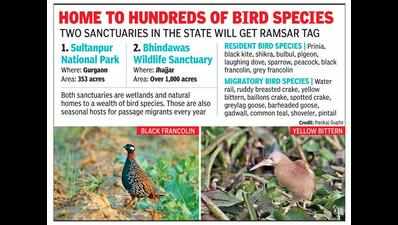- News
- City News
- gurgaon News
- Sultanpur among 2 sanctuaries in state likely to get ‘Ramsar’ tag
Trending
This story is from February 3, 2021
Sultanpur among 2 sanctuaries in state likely to get ‘Ramsar’ tag

Gurgaon: Haryana has decided to add two of its sanctuaries to the ‘wetlands of international importance’, or Ramsar, category of protected ecologically important sites. Sultanpur National Park in Gurgaon and Bhindawas Wildlife Sanctuary in Jhajjar are both wetlands that are natural homes to a wealth of bird species and seasonal hosts for migratory species. At present, India has 42 Ramsar sites.
The decision was taken by the Haryana forest and wildlife department on the occasion of the 50th World Wetland Day on Tuesday. Haryana has some 1,441 wetlands, but none is protected under the Ramsar treaty, as per the Union ministry of environment and forests data. The treaty is also known as the Convention on Wetlands. It is named after the city of Ramsar in Iran, where the convention was signed on February 2, 1971.
“Remembering the importance of wetland and preserving habitat, every year we observe the World Wetland Day on February 2. As we complete 50 years of this international treaty, we have decided to forward the names of two of our wetlands, which have the potential to get recognition as Ramsar sites,” ML Rajvanshi, chief conservator of forests (wildlife), Haryana, told TOI.
Sultanpur National Park covers 353 acres in Gurgaon, while Bhindawas Wildlife Sanctuary covers more than 1,000 acres of land in Jhajjar. Both the wetlands attract a large number of migratory birds every year. These include blackwinged stilt, pond heron, pied kingfisher, purple heron, shoveller, whitebreasted waterhen, munia, rosy pastor, drongo, ring dove, blue capped rock thrush, canary flycatcher and prinia.
There is a need to protect these wetlands as they serve as a habitat for diverse life forms and thus they should not be over-exploited, the wildlife department of Haryana has pointed out.
When asked about the definition of wetlands, the chief conservator said that these are areas of land that are either temporarily or permanently covered by water. This means that a wetland is neither truly aquatic nor terrestrial, and it is possible that they can be at the same time depending on seasonal variability. Thus, wetlands exhibit enormous diversity, according to their genesis, location, water regime and dominant plants.
Because of their transitional nature, the boundaries of wetlands are often difficult to define. Currently, there are over 2,400 Ramsar sites in the world.
The decision was taken by the Haryana forest and wildlife department on the occasion of the 50th World Wetland Day on Tuesday. Haryana has some 1,441 wetlands, but none is protected under the Ramsar treaty, as per the Union ministry of environment and forests data. The treaty is also known as the Convention on Wetlands. It is named after the city of Ramsar in Iran, where the convention was signed on February 2, 1971.
“Remembering the importance of wetland and preserving habitat, every year we observe the World Wetland Day on February 2. As we complete 50 years of this international treaty, we have decided to forward the names of two of our wetlands, which have the potential to get recognition as Ramsar sites,” ML Rajvanshi, chief conservator of forests (wildlife), Haryana, told TOI.
Sultanpur National Park covers 353 acres in Gurgaon, while Bhindawas Wildlife Sanctuary covers more than 1,000 acres of land in Jhajjar. Both the wetlands attract a large number of migratory birds every year. These include blackwinged stilt, pond heron, pied kingfisher, purple heron, shoveller, whitebreasted waterhen, munia, rosy pastor, drongo, ring dove, blue capped rock thrush, canary flycatcher and prinia.
When asked about the entire process, Rajvanshi said, “Within a week, the Haryana government will forward the details and paperwork to the Union ministry of environment, forests and climate change. Subsequently, a survey will be conducted by the ministry before sending the proposal to the Ramsar secretariat in Switzerland. The confirmation will be given by them.”
There is a need to protect these wetlands as they serve as a habitat for diverse life forms and thus they should not be over-exploited, the wildlife department of Haryana has pointed out.
When asked about the definition of wetlands, the chief conservator said that these are areas of land that are either temporarily or permanently covered by water. This means that a wetland is neither truly aquatic nor terrestrial, and it is possible that they can be at the same time depending on seasonal variability. Thus, wetlands exhibit enormous diversity, according to their genesis, location, water regime and dominant plants.
Because of their transitional nature, the boundaries of wetlands are often difficult to define. Currently, there are over 2,400 Ramsar sites in the world.
End of Article
FOLLOW US ON SOCIAL MEDIA










